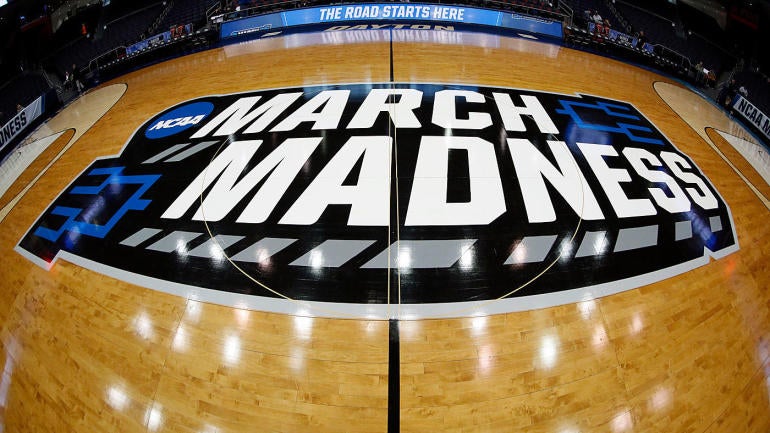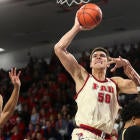
The long-awaited report of official recommendations from the NCAA Division I Transformation Committee was released Tuesday, and among the most notable items in the 39-page document is the previously reported action that would enable Division I sports to field postseason tournaments that accommodate as much as 25% of a sport's membership.
The caveat being: only sports with at least 200 schools participating would be empowered to potentially act on that 25% number.
One potential outcome of these recommendations could be down-the-road expansion of the men's and women's NCAA basketball tournaments. However, industry sources have told CBS Sports there is not a lot of momentum for that change in the near future. There remains the possibility the NCAA Tournament doesn't expand at all, sources told CBS Sports. If the committee's full range of recommendations are formally adopted, as is expected at next week's NCAA Convention, it would allow for the men's and women's tournaments to expand from their current size of 68 to as many as 90 (out of 363 schools). Conversely, if expansion ever did happen, it might also mean an increase on a minor scale: going from 68 to 72.
The NCAA Tournament's contract with CBS and Warner Bros. Discovery Sports runs through 2032.
Over the past 12 months the committee looked at: what it meant to be and/or qualify as a Division I institution; what the student-athlete experience was, and how it could be improved; how all D-I sports are governed; how postseason championships are built and the access protocols for qualification; how the money is shared across Division I; the student-athlete transfer environment; and enforcement of the NCAA's slimmed-down rulebook.
The 21-person panel was formed at the instruction of outgoing NCAA president Mark Emmert, who prompted action after a landmark antitrust case by the Supreme Court went 9-0 against the NCAA in June 2021. The committee was co-chaired by SEC commissioner Greg Sankey and Ohio University athletic director Julie Cromer. The group met on a mostly weekly basis throughout 2022, their charge being to change both big-picture features and more granular particulars of Division I.
But the report isn't the landscape-changing event that many in college athletics were anticipating. If anything, a lot of what was released Tuesday was telegraphed for months by Sankey and Cromer in their previous comments to media and in closed-door discussions with higher-ups in college athletics this past fall. Many of these recommendations are expected to take years to ratify. For the intents and purposes of their effects on college sports to the average fan, many of the shifts won't be discernible.
Division I is not going to shrink in size and it is not going to be split up into multiple tiers, as was previously speculated on.
"We also made a critical choice early on to maintain a 'big tent' approach for Division I," the report states. "While the breadth and diversity of Division I presents challenges, it's also a fundamental part of the magic that is college sports. In the committee's view — and in the view of most outside voices who joined us — breaking Division I apart would damage what is vital and essential about college sports. So long as their universities can meet minimum expectations in terms of the support they provide, ultimately, we want as many student-athletes as possible to start each season with Division I national championship dreams."
For football, the committee asked that the attendance requirements to participate in FBS be examined, "to determine the appropriateness of maintaining the current attendance standard while focusing on other elements that more directly link the student-athlete experience to expectations for FBS membership criteria. This review should be established by the Division I Board of Directors, involve experts and key leaders from the FBS membership and focus on establishing more effective distinctions between the football subdivision."
Ultimately, the committee opted against recommending college football to move away from being legislated under the NCAA's purview. Throughout 2022, there was lingering curiosity that the sport might break away entirely from the NCAA, but that is not part of the calculus here.
The recommendations are not mandates, and the full set of them are set to be voted on by the Division I Board of Directors at the annual NCAA Convention in San Antonio, Texas, next week.
One of the primary points of change the committee wants, and what leads the report, is "Elevating Support for Student-Athletes' Mental, Physical and Academic Well-Being." The recommendation, if approved, would require every D-I institution to account for health insurance for any and all injuries related to athletic endeavors in college — including two years after graduation.
The committee also recommended enhanced and expanded benefits for college athletics, including financial support, travel expenses, food and a variety of other everyday benefits.
The committee is also encouraging each sport to allow self-governance, which would decrease the autonomy of rules and guidelines interlacing all sports across D-I. This would mean that women's field hockey could deliberate and enact its own set of rules, even scheduling and recruiting calendars, that would be different from men's soccer, women's basketball or men's lacrosse.
What would be universal across Division I is the standards and expectations for support and enhancement of the college athlete experience.
There are also recommendations to allow for more NCAA revenue to help schools in need of meeting some redefined specifications when it comes to student-athlete wellbeing. For many universities, being able to afford the resources required in these recommendations will take an influx of funds that those schools don't have right now.
The committee recommended the NCAA take a look at how revenue is shared across D-I, and that a change in how money is provided be updated. For decades, the only money-making entity in the NCAA has been the men's NCAA Tournament. How schools and conferences performed in March Madness determined how much money was split up among all leagues in multi-year increments. That system could be changing down the road.
The committee also recommended more student-athlete representation in decision-making in every D-I sport. Under these new guidelines, all college athletes would be entitled to four years worth of scholarship money, no matter if they transfer or not, and would be entitled to finish their degree on scholarship in a 10-year period following someone leaving college early, if they opted to.
The phrase "name, image and likeness" appears five times in the committee's report, with all references tied to educational endeavors and/or matters surrounding litigation. There is no set of standards on NIL included in the committee's work here. The NCAA is hoping for a national standard to be determined by Congress, but many in college athletics have expressed cynicism over the likelihood of that ever materializing.





















